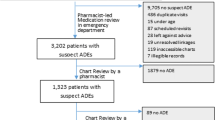Summary
Within an ongoing drug surveillance project (AMÜP) in psychiatric hospitals, a comparative study was carried out to evaluate two methods commonly used in the field of adverse drug reaction assessment. Two raters, who have cooperated with the project since its inception, evaluated 80 randomly selected ADRs twice; first, by an empirical (implicit) approach, and second, 4 weeks later, by using an algorithm as proposed by Kramer et al. 1979. Agreement on medication and related probability ratings was obtained in 81% of all 80 cases for the empirical method (weighted Kappa=0.41), and in 69% for the algorithmic method (weighted Kappa=0.62), indicating that agreement exceeded chance for both methods. By comparison with assessments made in previous case conferences of the project, empirical ratings were found to be reliable over time due to homogeneous use of criteria by project raters. In contrast to the reports on the subject, agreement between raters appeared to be superior in the empirical method as compared to the algorithmic assessment. Analysis of disagreements suggested that probability ratings based on the empirical method were nonspecific, due to conventional criteria applied in the project. Inter-rater agreement was reduced by polypharmacy, especially in the case of algorithmic assessments. The consistency of assessment was also lowered by the fact that the 2 methods assigned different weights to particular assessment criteria.
Similar content being viewed by others
References
Ruether E, Benkert O, Eckmann F, Eckmann J, Grohmann R, Helmchen H, Hippius H, Müller-Oerlinghausen B, Poser W, Schmidt LG, Stille G, Strauss A, Überla K (1980) Drug Monitoring in psychiatrischen Kliniken. Arzneimittelforsch/Drug Res 30 (II): 1181–1183
Grohmann R, Hippius H, Müller-Oerlinghausen B, Rüther E, Scherer J, Schmidt LG, Strauss A, Wolf B (1984) Assessment of adverse drug reactions in psychiatric hospitals. Eur J Clin Pharmacol 26: 727–734
Schmidt LG, Grohmann R, Helmchen H, Langscheid-Schmidt K, Müller-Oerlinghausen B, Poser W, Rüther E, Scherer J, Strauss A, Wolf B (1984) Adverse drug reactions — an epidemiological study at psychiatric hospitals. Acta Psychiatr Scand 70: 77–89
Venulet J (1982) Assessing causes of adverse drug reactions with special reference to standardized methods. Academic Press, London
Karch FE, Smith CL, Kerzner B, Mazullo M, Weintraub M, Lasagna L (1976) Adverse drug reactions — a matter of opinion. Clin Pharmacol Ther 19: 489–492
Karch FE, Lasagna L (1977) Towards the operational identification of adverse drug reactions. Clin Pharmacol Ther 21: 247–254
Kramer MS, Leventhal JM, Hutchinson TA, Feinstein AR (1979) An algorithm for the operational assessment of adverse drug reactions. I. Background, description and instruction for use. J Am Med Assoc 242: 623–632
Naranjo CA, Busto U, Sellers EM, Sandor P, Ruiz I, Roberts EA, Janacek E, Domecq C, Greenblatt DJ (1981) A method for estimating the probability of adverse drug reactions. Clin Pharmacol Ther 30: 239–245
Karch FE, Lasagna L (1975) Adverse drug reactions. J Am Med Assoc 234: 1236–1241
Seidl LG, Thornton GF, Cluff LE (1965) Epidemiological studies of adverse drug reactions. Am J Public Health 55: 1170–1175
Hurwitz N, Wade OL (1969) Intensive hospital monitoring of adverse reactions to drugs. Br Med J 1: 531–536
Martindale W (1982) The extra pharmacopoeia (28th edn) Pharmaceutical Press, London
Cohen J (1968) Weighted Kappa: Nominal scale agreement with provision for scaled disagreement of partial credit. Psychol Bull 70: 213–220
Kramer MS, Feinstein AR (1981) Clinical biostatics. LIV. The biostatics of concordance. Clin Pharmacol Ther 29: 111–123
Hutchinson TA, Leventhal JM, Kramer MS, Karch FE, Lipman AG, Feinstein AR (1979) An algoritm for the operational assessment of adverse drug reactions. II. Demonstration of reproducibility and validity. J Am Med Assoc 242: 633–638
Leventhal JM, Hutchinson TA, Kramer MS, Feinstein AR (1979) An algorithm for the operational assessment of adverse drug reactions. III. Results of test among clinicians. J Am Med Assoc 242: 1991–1994
Blanc S, Leuenberger P, Berger JM, Brooke EM, Schelling JL (1979) Judgment of trained observers on adverse drug reactions. Clin Pharmacol Ther 25: 493–498
Hutchinson TA, Flegel KM, Hopingkong H, Bloom WS, Kramer MS, Trummer EG (1983) Reasons for disagreement in the standardized assessment of suspected adverse drug reactions. Clin Pharmacol Ther 34: 421–426
Grohmann R, Dirschedl P, Scherer J, Schmidt LG, Wunderlich O (1985) Reliability of adverse drug reaction assessment in psychiatric in-patients. Eur Arch Psychiatr Neurol Sci 235: 158–163
Begaud B, Boisseau A, Dangoumau J (1981) Comparaison de quatre méthodes d'imputabilité des effets indésirables des médicaments. Thérapie 36: 65–70
Pere JC, Begaud B, Haramburu F, Albin H (1984) Méthodes d'étude des effets indésirables des médicamentes. II. Profil et comparaison de cinq méthodes d'imputabilité. Thérapie 39: 369–378
Miller RR, Greenblatt DJ (eds), (1976) Drug effects in hospitalized patients. Experiences of the Boston Collaborative Drug Surveillance Program 1966–1975. Wiley & Sons, New York
Koch-Weser J, Sellers EM, Zacest R (1977) The ambiguity of adverse drug reactions. Eur J Clin Pharmacol 11: 75–78
Grohmann R, Strauss A, Gehr C, Rüther E, Hippius H (1980) Zur Praxis der Klinischen Therapie mit Psychopharmaka. Pharmacopsychiatry 13: 1–19
Schmidt LG, Niemeyer R, Müller-Oerlinghausen B (1983) Drug prescribing pattern of a psychiatric university hospital in Germany. Pharmacopsychiatry 16: 35–42
Kewitz H (1977) Erhebungen über die Arzneitherapie in der Klinik. Verh Dtsch Ges Inn Med 83: 1487–1502
Weber E, Hollmann M (eds), (1981) Drug utilization studies in hospitals. Schattauer, Stuttgart New York
Louik C, Lacouture PG, Mitchell AA, Kaufmann R, Lovejoy FH, Summer SJ, Shapiro S (1985): A study of adverse reaction algorithms in a drug surveillance program. Clin Pharmacol Ther 38: 183–187
Author information
Authors and Affiliations
Additional information
Dedicated to Prof. Dr. H. Kewitz, Head of the Department of Clinical Pharmacology, Klinikum Steglitz, Berlin (West), on the occasion of his 65th birthday
Rights and permissions
About this article
Cite this article
Schmidt, L.G., Dirschedl, P., Grohmann, R. et al. Consistency of assessment of adverse drug reactions in psychiatric hospitals: A comparison of an algorithmic and an empirical approach. Eur J Clin Pharmacol 30, 199–204 (1986). https://doi.org/10.1007/BF00614303
Received:
Accepted:
Issue Date:
DOI: https://doi.org/10.1007/BF00614303




